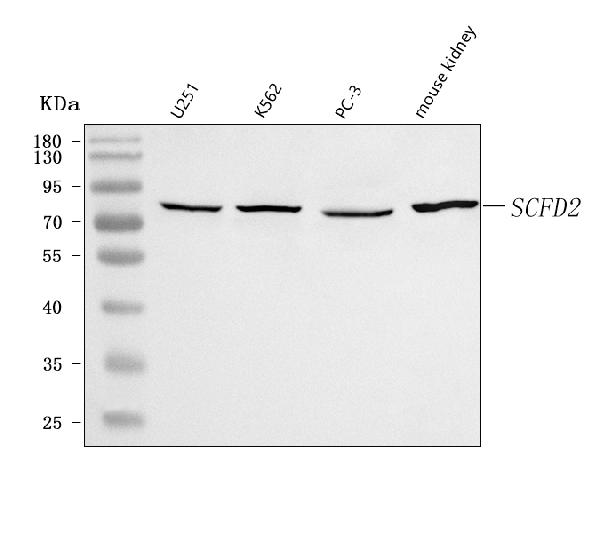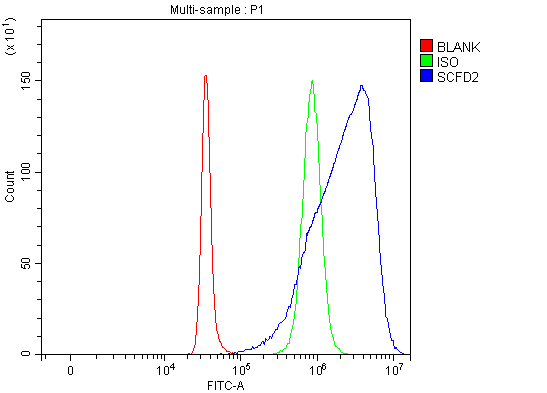Product Info Summary
| SKU: | A15482-1 |
|---|---|
| Size: | 100 µg/vial |
| Reactive Species: | Human, Mouse |
| Host: | Rabbit |
| Application: | ELISA, Flow Cytometry, IF, ICC, WB |
Customers Who Bought This Also Bought
Product info
Product Name
Anti-SCFD2 Antibody Picoband®
SKU/Catalog Number
A15482-1
Size
100 µg/vial
Form
Lyophilized
Description
Boster Bio Anti-SCFD2 Antibody Picoband® catalog # A15482-1. Tested in ELISA, IF, ICC, WB, Flow Cytometry applications. This antibody reacts with Human, Mouse. The brand Picoband indicates this is a premium antibody that guarantees superior quality, high affinity, and strong signals with minimal background in Western blot applications. Only our best-performing antibodies are designated as Picoband, ensuring unmatched performance.
Storage & Handling
At -20°C for one year from date of receipt. After reconstitution, at 4°C for one month. It can also be aliquotted and stored frozen at -20°C for six months. Avoid repeated freezing and thawing.
Cite This Product
Anti-SCFD2 Antibody Picoband® (Boster Biological Technology, Pleasanton CA, USA, Catalog # A15482-1)
Host
Rabbit
Contents
Each vial contains 4 mg Trehalose, 0.9 mg NaCl, 0.2 mg Na2HPO4.
Clonality
Polyclonal
Isotype
Rabbit IgG
Immunogen
E.coli-derived human SCFD2 recombinant protein (Position: K20-H585).
*Blocking peptide can be purchased. Costs vary based on immunogen length. Contact us for pricing.
Cross-reactivity
No cross-reactivity with other proteins.
Reactive Species
A15482-1 is reactive to SCFD2 in Human, Mouse
Reconstitution
Adding 0.2 ml of distilled water will yield a concentration of 500 µg/ml.
Observed Molecular Weight
75 kDa
Calculated molecular weight
24145 MW
Background of SCFD2
SCFD2 (sec1 family domain containing 2), also known as STXBP1L1 (syntaxinbinding protein 1-like 1), is a 684 amino acid protein suggested to play a role in protein transport. Existing as two alternatively spliced isoforms, SCFD2 is a member of the STXBP/unc-18/SEC1 family and is encoded by a gene that maps to human chromosome 4q12. Chromosome 4 represents approximately 6% of the human genome and contains nearly 900 genes. Notably, the Huntingtin gene, which is found to encode an expanded glutamine tract in cases of Huntington’s disease, is on chromosome 4. FGFR-3 is also encoded on chromosome 4 and has been associated with thanatophoric dwarfism, achondroplasia, Muenke syndrome and bladder cancer. Chromosome 4 is also tied to Ellis-van Creveld syndrome, methylmalonic acidemia and polycystic kidney disease
Antibody Validation
Boster validates all antibodies on WB, IHC, ICC, Immunofluorescence, and ELISA with known positive control and negative samples to ensure specificity and high affinity, including thorough antibody incubations.
Application & Images
Applications
A15482-1 is guaranteed for ELISA, Flow Cytometry, IF, ICC, WB Boster Guarantee
Assay Dilutions Recommendation
The recommendations below provide a starting point for assay optimization. The actual working concentration varies and should be decided by the user.
Western blot, 0.25-0.5 μg/ml, Human, Mouse
Immunocytochemistry/Immunofluorescence, 5 μg/ml, Human
Flow Cytometry (Fixed), 1-3 μg/1x106 cells, Human
ELISA, 0.1-0.5 μg/ml, -
Positive Control
WB: human U251 whole cell, human K562 whole cell, human PC-3 whole cell, mouse kidney tissue
ICC/IF: HELA cell
FCM: SH-SY5Y cell
Validation Images & Assay Conditions

Click image to see more details
Figure 1. Western blot analysis of SCFD2 using anti-SCFD2 antibody (A15482-1).
Electrophoresis was performed on a 5-20% SDS-PAGE gel at 70V (Stacking gel) / 90V (Resolving gel) for 2-3 hours. The sample well of each lane was loaded with 30 ug of sample under reducing conditions.
Lane 1: human U251 whole cell lysates,
Lane 2: human K562 whole cell lysates,
Lane 3: human PC-3 whole cell lysates,
Lane 4: mouse kidney tissue lysates.
After electrophoresis, proteins were transferred to a nitrocellulose membrane at 150 mA for 50-90 minutes. Blocked the membrane with 5% non-fat milk/TBS for 1.5 hour at RT. The membrane was incubated with rabbit anti-SCFD2 antigen affinity purified polyclonal antibody (Catalog # A15482-1) at 0.5 μg/mL overnight at 4°C, then washed with TBS-0.1%Tween 3 times with 5 minutes each and probed with a goat anti-rabbit IgG-HRP secondary antibody at a dilution of 1:5000 for 1.5 hour at RT. The signal is developed using an Enhanced Chemiluminescent detection (ECL) kit (Catalog # EK1002) with Tanon 5200 system. A specific band was detected for SCFD2 at approximately 75 kDa. The expected band size for SCFD2 is at 75 kDa.

Click image to see more details
Figure 2. IF analysis of SCFD2 using anti-SCFD2 antibody (A15482-1).
SCFD2 was detected in an immunocytochemical section of HELA cells. Enzyme antigen retrieval was performed using IHC enzyme antigen retrieval reagent (AR0022) for 15 mins. The cells were blocked with 10% goat serum. And then incubated with 5 μg/mL rabbit anti-SCFD2 Antibody (A15482-1) overnight at 4°C. DyLight®488 Conjugated Goat Anti-Rabbit IgG (BA1142) was used as secondary antibody at 1:500 dilution and incubated for 30 minutes at 37°C. The section was counterstained with DAPI. Visualize using a fluorescence microscope and filter sets appropriate for the label used.

Click image to see more details
Figure 3. Flow Cytometry analysis of SH-SY5Y cells using anti-SCFD2 antibody (A15482-1).
Overlay histogram showing SH-SY5Y cells stained with A15482-1 (Blue line). The cells were fixed with 4% paraformaldehyde and blocked with 10% normal goat serum. And then incubated with rabbit anti-SCFD2 Antibody (A15482-1, 1 μg/1x106 cells) for 30 min at 20°C. DyLight®488 conjugated goat anti-rabbit IgG (BA1127, 5-10 μg/1x106 cells) was used as secondary antibody for 30 minutes at 20°C. Isotype control antibody (Green line) was rabbit IgG (1 μg/1x106) used under the same conditions. Unlabelled sample (Red line) was also used as a control.
Protein Target Info & Infographic
Gene/Protein Information For SCFD2 (Source: Uniprot.org, NCBI)
Gene Name
SCFD2
Full Name
Sec1 family domain-containing protein 2
Weight
24145 MW
Superfamily
STXBP/unc-18/SEC1 family
Alternative Names
Kelch repeat and BTB domain-containing protein 2; BTB and kelch domain-containing protein 1; KBTBD2; BKLHD1; KIAA1489 SCFD2 STXBP1L1 sec1 family domain containing 2 sec1 family domain-containing protein 2|syntaxin binding protein 1-like 1
*If product is indicated to react with multiple species, protein info is based on the gene entry specified above in "Species".For more info on SCFD2, check out the SCFD2 Infographic

We have 30,000+ of these available, one for each gene! Check them out.
In this infographic, you will see the following information for SCFD2: database IDs, superfamily, protein function, synonyms, molecular weight, chromosomal locations, tissues of expression, subcellular locations, post-translational modifications, and related diseases, research areas & pathways. If you want to see more information included, or would like to contribute to it and be acknowledged, please contact [email protected].
Specific Publications For Anti-SCFD2 Antibody Picoband® (A15482-1)
Loading publications
Recommended Resources
Here are featured tools and databases that you might find useful.
- Boster's Pathways Library
- Protein Databases
- Bioscience Research Protocol Resources
- Data Processing & Analysis Software
- Photo Editing Software
- Scientific Literature Resources
- Research Paper Management Tools
- Molecular Biology Software
- Primer Design Tools
- Bioinformatics Tools
- Phylogenetic Tree Analysis
Customer Reviews
Have you used Anti-SCFD2 Antibody Picoband®?
Submit a review and receive an Amazon gift card.
- $30 for a review with an image
0 Reviews For Anti-SCFD2 Antibody Picoband®
Customer Q&As
Have a question?
Find answers in Q&As, reviews.
Can't find your answer?
Submit your question




